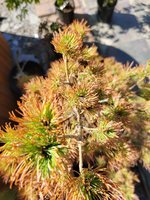tsamajama
Seedling
Hi Everyone,
I'm a noob. I've been growing some stock trees for about four years one of which is a beloved Japanese White Pine. I moved the tree from Northern VA to Boulder, CO a couple of years ago and the climate here is very different from VA - much drier, greater temp swings from day to night, and colder winters. It survived the first winter just fine but this year, the needles started turning brown at the tips and about half have fallen off. I suspect root rot; I probably overwatered in the winter. And the tree was left outside a few times well below freezing such that the roots likely froze. The candles appear to be forming, but I'm wondering if this is a case of root rot? If so, would Phyton 27 or 35 or some other systemic fungicide help? I cut way back on watering a few weeks ago, but the soil is still damp. The weather is finally becoming spring-like and warm, but the nights are in the high 30's to low 40's (Fahrenheit), so it will be a while before the soil dries out further. Any help or advice would be appreciated!
Tarek

I'm a noob. I've been growing some stock trees for about four years one of which is a beloved Japanese White Pine. I moved the tree from Northern VA to Boulder, CO a couple of years ago and the climate here is very different from VA - much drier, greater temp swings from day to night, and colder winters. It survived the first winter just fine but this year, the needles started turning brown at the tips and about half have fallen off. I suspect root rot; I probably overwatered in the winter. And the tree was left outside a few times well below freezing such that the roots likely froze. The candles appear to be forming, but I'm wondering if this is a case of root rot? If so, would Phyton 27 or 35 or some other systemic fungicide help? I cut way back on watering a few weeks ago, but the soil is still damp. The weather is finally becoming spring-like and warm, but the nights are in the high 30's to low 40's (Fahrenheit), so it will be a while before the soil dries out further. Any help or advice would be appreciated!
Tarek





